Nosy Crow's Blog, page 61
May 31, 2019
No Ballet Shoes in Syria on Down the Rabbit Hole
The latest episode of Down the Rabbit Hole aired this week, and one of this month’s featured books was No Ballet Shoes in Syria by Catherine Bruton – a captivating story, filled with warmth and heart, with wonderfully authentic ballet writing and an important message championing the rights of refugees. And if you didn’t manage to catch it live, you can listen to the episode on catch-up now!
No Ballet Shoes in Syria tells the story of Aya – eleven years old and newly arrived in Britain with her mum and baby brother, seeking asylum from war in Syria. When Aya stumbles across a local ballet class, the formidable dance teacher spots her exceptional talent and believes that Aya has the potential to earn a prestigious ballet scholarship. But at the same time, Aya and her family must fight to be allowed to remain in the country, to make a home for themselves and to find Aya’s father – separated from the rest of the family during the journey from Syria. Perfect for fans of Noel Streatfeild’s Ballet Shoes, Lorna Hill’s Sadlers Wells series, and Pamela Brown’s The Swish of the Curtain, this is beautiful, classic storytelling.
You can listen to the latest episode of Down the Rabbit Hole, featuring special guest Maz Evans, below, or at this page.
And that’s not all! No Ballet Shoes in Syria has also been named Booktrust’s Book of the Day – in their review of the book, Booktrust write:
“Children who love stories of performance and friendship will enjoy this book. The story humanises Aya, showing her as much more than just her circumstances. The reality of her history never overwhelms the essential romance of the story.
The book is ideal for readers who enjoy shedding a cathartic tear, but need an optimistic ending. Fans of Noel Streatfield will find much that is familiar and fun.”
You can read Booktrust’s full review here.
And you can read the opening chapters of No Ballet Shoes in Syria below:
And you can listen to a preview of the audiobook below:

An Introduction to Children’s Publishing
Today we’re incredibly pleased to announce a new event that we’ll be holding this year: An Introduction to Children’s Publishing.
This will be a free, ticketed event at the Nosy Crow offices on the evening of Wednesday 10th July, designed for people who are interested in working in children’s publishing, as a way of learning more about the industry – no prior knowledge or experience is necessary.
The evening will begin with an introduction and welcome from our Managing Director, Kate Wilson, and then in small groups you’ll have a chance to meet someone from each of our Editorial, Marketing, Production, Publicity, Rights, and Sales teams, who’ll each give a brief overview of what their job involves and answer any questions you might have about working in children’s publishing and the opportunities available. There’s also be a chance to chat with each other, and staff at Nosy Crow, at the end of the evening, and refreshments will be provided.
Where is it?
This event will take place at the Nosy Crow offices in London, near London Bridge station (you can find us on a map here). We are aware that cost of travel can be an issue for those outside London, and we’re partnering with The Book Trade Charity who may be able to offer financial assistance for those who would need it for travel to the event. The office is wheelchair accessible.
How to Apply?
We’re offering 24 places for the evening; applications are open to anyone who is 18+ and will be judged blind. No prior experience of children’s publishing is expected, and we would particularly like to encourage anyone from a BAME or under-represented background to apply.
To apply for a place, all we would like is an answer to the question below in no more than 150 words.
Loading…
Applications will close on the 17th June at midnight, and we’ll be notifying those who’ve been successful by the 19th June.
If you have any questions, please email frances@nosycrow.com with An Introduction to Children’s Publishing in the subject heading.

May 28, 2019
I Am The Seed and Where’s Mr Duck? have been shortlisted in the Junior Design Awards
The 2019 Junior Design Awards shortlist has been released, and we are thrilled to see that it includes both I Am the Seed That Grew the Tree: A Nature Poem for Every Day of the Year and Where’s Mr Duck!
The Junior Design Awards are run by parenting magazine Junior and celebrate “the very best and most beautiful products on the planet”– so we are thrilled to have made the shortlist!
I Am The Seed That Grew The Tree, has been shortlisted for Best Designed/Illustrated Book for Children. I Am the Seed That Grew the Tree, illustrated by Frann Preston-Gannon and collected by Fiona Waters, is a lavishly illustrated collection of 366 nature poems – one for every day of the year, including leap years. Filled with familiar favourites and new discoveries, written by a wide variety of poets, this is the perfect book for children (and grown-ups!) to share at the beginning or the end of the day, or just to dip into.
Here’s a look inside the book:
Where’s Mr Duck? has been shortlisted for Best Baby/Pre-Schooler Book 0-4 Years. Where’s Mr Duck? is part of our hugely popular Felt Flaps board book series for pre-schoolers. With easy-to-grasp, shaped felt flaps, a repetitive refrain and beautiful artwork from Swedish homewares designer, Ingela Arrhenius.

The Junior Design Awards winners will be announced in August, and you can see the past winner here.
Best of luck to Fiona, Frann, and Ingela!

May 22, 2019
Take a first look at our cover for I, Cosmo – and win a proof of the book
This August we are publishing I, Cosmo by Carlie Sorosiak – and this week we’re delighted to share the cover for the first time. And to celebrate, we have three proof copies of the book to give away!
A moving, funny, and tender story for 9-12 readers, with a wonderfully unique hero and an incredible voice, I, Cosmo is perfect for fans of Rebecca Stead and Kate DiCamillo – Charlotte’s Web meets Little Miss Sunshine.
Cosmo’s family is falling apart.
And it’s up to Cosmo to keep them together.
He knows exactly what to do.
There’s only one problem.
Cosmo is a Golden Retriever.
Filled with warmth and heart, I, Cosmo is the story of one dog’s attempt to save his family, become a star, and eat a lot of bacon.
You can see our beautiful cover for I, Cosmo, fantastically illustrated by Ben Mantle, at the top of this post – and here’s a closer look:

You can pre-order the book here – and to enter our proof giveaway on Twitter, re-tweet the message below and reply with your favourite dog picture!
To celebrate the cover reveal for @carliesorosiak’s incredible new middle-grade novel, I, COSMO, we have three rare proof copies to give away! RT this message and reply with your favourite dog picture to enter to win! #ICOSMO pic.twitter.com/xLxaI4RQcu
— Nosy Crow (@NosyCrow) May 20, 2019
The proof giveaway is running until May 24th – good luck!

May 21, 2019
Unpacking The Suitcase – a guest post by Chris Naylor-Ballesteros
This month we’re incredibly proud to have published The Suitcase by Chris Naylor-Ballesteros – a powerful new picture book full of heart and humanity. And today we’re very pleased to share a piece by Chris on the development of the story, which you can read below.
The Suitcase was intended as a follow-up to my two previous books – I’m Going To Eat This Ant and I Love You Stick-Insect. I started out trying to emulate the tone of the first two, ie. light-hearted, humorous, slightly surreal, and based on another fundamental human need. Having covered food and love, I thought the next obvious subject was shelter or home. And I thought I’d be able to come up with something but in fact I really struggled. I had a few things in mind but none that provoked that lovely feeling where an idea feels lively and sparks excitement and you know if you dig around enough you’ll find a story to hang on it.
In the end, I was absent-mindedly sketching and doodling and I scribbled this fraught-looking animal carrying something big over his head. Who is it? What’s it carrying? A box? A case? Why does it look so worried? Who’s it running from?

Early character sketches
At last this idea felt like something to grab hold of and work out. I don’t remember mentally putting the story together but did set out to follow my previous books’ theme of a character who confuses reality and fantasy and things become increasingly silly or incredulous until there’s some sort of unexpected punchline at the end. But instead of mirroring those books’ comic reveals, this story’s twist was more emotional and heartfelt. It seemed that thinking about and imagining one’s home whilst not being in it or even having one was inevitably disturbing, unsettling and melancholy and didn’t suit a humorous resolution at all. So it had to go in another direction because I think the notion of home is so fundamentally a part of our sense of self. I didn’t set out to write a story explicitly about a refugee but it is obviously open to that interpretation. I also like to think it could apply to any unexpected arrival that needs help and acceptance but might disturb established relationships and situations: the child that suddenly arrives out of nowhere at your school in the middle of term, the new family in your street who are apprehensive and shy. And, of course, the person who is fleeing poverty or war and has taken a huge risk to find stability and shelter. I hoped my stranger could be seen as any of these things.

So after a month or two of struggling to find a story, I finally felt I had one. I recounted it to my children one morning and at the end one of them said “It makes me want to cry but I’m not sad.” This was great news – children on the verge of tears at breakfast – yesss! It’s very easy to lose a sense of objectivity on your own ideas. Stuff you think has potential is sometimes met with ‘hmmm… not bad, yeah…no’ or things you think aren’t anything too special get a big thumbs up. So my family are the first sounding board and this story seemed to pass that first hurdle, where many others fall flat on their underdeveloped, badly-thought-out faces.
Next step – Jo Williamson, my agent was also very positive about it so I worked up the text and some sketches. The submitted version had the first two pages worked up in ink/watercolour to give an idea of style and the rest were rough sketches, just to get the story across. Nosy Crow got back to us quickly to say they really liked it and snapped it up. That makes it sound like getting a contract was a piece of cake but in reality getting a book deal is never actually this simple – there were, as always, previous periods of waiting and then disappointments and frustrations but it’s true to say that as soon as Nosy Crow saw it, they were very enthusiastic and decisive and it all went pretty quickly and smoothly from then on.

The basic story hardly changed from submission to publication. But there were many modifications, some quite large, lots small. I had too many characters, for example. The group that the stranger confronts numbered five and Louise, my editor at Nosy Crow, rightly knew this was too many. So goodbye hedgehog-type-thing, goodbye badger/bear-sort-of-thing. Louise also saw potential for extending the animals’ discussion about opening the case or not and gave me an extra double page to develop that dialogue.
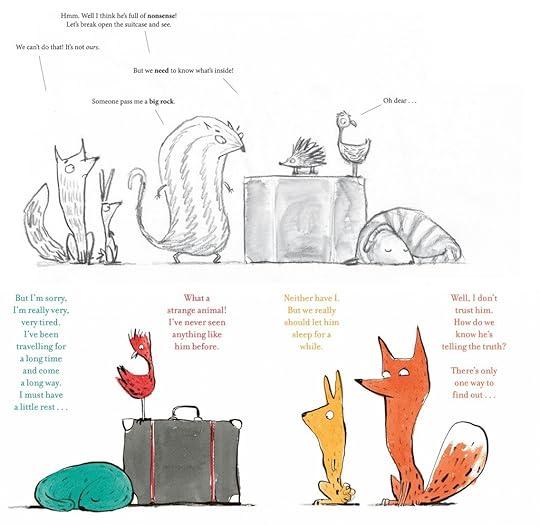
Rough artwork (top) and the final version (bottom)
Then a small but important change at the end of the story: my stranger originally asked for “more chairs” but Louise (spot on, again) noted that, unbeknownst to me, The Day War Came by Nicola Davies and Rebecca Cobb brilliantly uses chairs to symbolise welcome and acceptance.
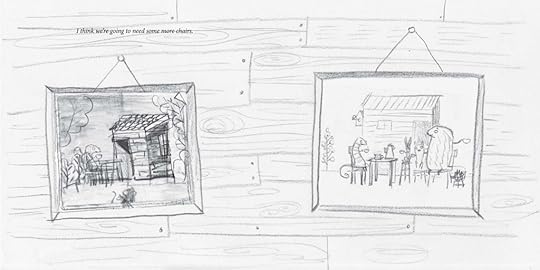
So, well… we changed it to teacups – some solutions are just sitting there waiting to be used. Then there was the usual fine-tuning, tooth-comb streamlining of text, to make sure the story and emotions got across in most effective way in harmony with the images.
For the images, the toughest part initially was developing the character design from my original versions. Along with Louise, I worked with Nia Roberts, the book designer at Nosy Crow to get this right and she was invaluable in guiding me along the way until we were all happy with it. As ever, lots of sketching and inking, trying things out until everyone gets the lovely feeling that it’s actually, slowly getting there.

Three iterations of the same spread, from left to right
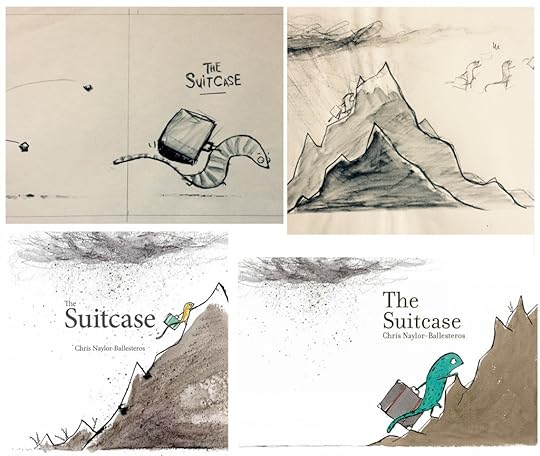

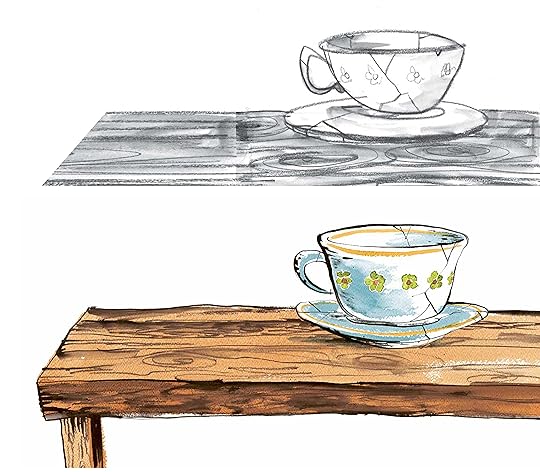
Rough teacup artwork (top) and the final coloured version (bottom)
There are countless little considerations that make a book better and one example of this was the stranger’s tail. Because it was quite long I liked to draw it wriggling or curling around a bit, or being used to cover the stranger’s eyes when he’s on the ground but Nia and Louise felt that it was looking a bit like a character in its own right, distracting from the real character and therefore the story. They had a point and I shortened and reined-in the playful tail. Readers’ eyes have to be directed where you want them and if a funny, wriggly but narratively irrelevant tail is scene-stealing then you’re failing the story. We also had a lot of discussion about the tail when the stranger is asleep – where does it go? How long should it be? Does it dip below the ‘ground-line’ or stay above it? Attention to minute detail but worth the effort.
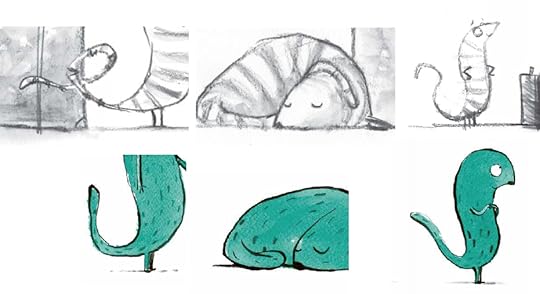
Developing the tail
Another change was to the imaginary/memory scenes. I’d intended to have the stranger within them – appearing to sit at the table he’s describing, having a cuppa at the imagined shed, even with the group animals looking on from the bottom of the hill, to blur the reality/fantasy boundary but Louise and Nia felt (right again) that the boundary was too blurred and it could lead to confusion in younger readers – has he gone back home? Has he taken the group with him? You can’t risk those kind of misunderstandings so the imaginary scenes were left uninhabited and also coloured sepia, to divide them even more clearly from the ‘real world’.

Rough artwork (top) and the final version (bottom)
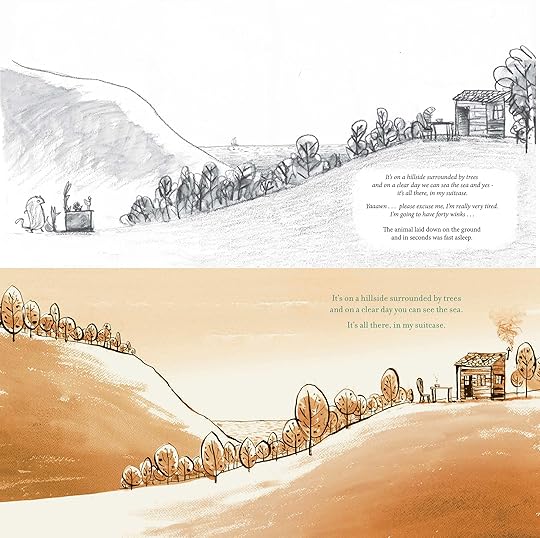
Rough artwork (top) and the final version (bottom)
We also discussed hand-inking all the text but again, it was a distraction, drawing attention away from the illustrations and the story so we went with a very nice, clean, serif typeface that Nia suggested and I loved. We also all agreed that there should be no playfulness in the typography – no size-variations, bolds or italics, words on a curve or at an angle. The story ought to tell itself without those tricks, even if they can be effective in other kinds of story. One exception was using colour to link speech to characters. Obviously, the animals were placed on the page so that the dialogue would read in the right order but Nia and Louise wanted to make that clearer and colour code each phrase to each animal and distinguish dialogue from narration. I think it was a great idea and looks lovely.

Developing a sketched story to a finished picture book is a very collaborative process and everyone brings there own expertise and style to it. I was very lucky to have worked with Louise and Nia on The Suitcase because we were all very much on the same wavelength as to what the story should be and how it should be presented and the process was thoroughly enjoyable from start to end. That said, I do think the stranger’s tail is just a tiny tiny tad too short, ha ha..!
Thank you, Chris! The Suitcase is available in shops now – you can take a look inside the book below:

May 20, 2019
Take a first look inside How to be an Astronaut and Other Space Jobs
Next month we’re delighted to publish How to be an Astronaut and Other Space Jobs, written by Dr Sheila Kanani and illustrated by Sol Linero – and today you can take a very first look in the book.
Learn all about space – and jobs in the space industry! This is is the start of an exciting new series introducing children to different professions, written by experts in each field. Learn all about space and what it takes to be an astronaut, from surviving a space-walk to living in the International Space Station. Children can also discover what other people in the space industry do, including engineers, Mission Control staff, space chefs, designers and more. Written by NASA award-winning planetary scientist Sheila Kanani of the Royal Astronomical Society and accompanied by bright, graphic illustrations by Sol Linero, this book will inspire any girl or boy with an interest in science and space exploration.
Here’s a look inside:
How to be an Astronaut and Other Space Jobs will be in shops in June – you can pre-order the book here, and if you’d like to keep up to date with all our new books, you can sign up to our books newsletter at this page, or with the form below.
NameEmail
Books
Apps
CommentsThis field is for validation purposes and should be left unchanged.

May 16, 2019
No Ballet Shoes in Syria has been shortlisted for a 2019 IBW Book Award!
The shortlists for the 2019 Independent Bookshop Week (IBW) Book Awards have been announced, and we are delighted that No Ballet Shoes in Syria by Catherine Bruton has been shortlisted in the Children’s category!
The shortlists of the IBW Awards, now in their 13th year, are voted for by independent booksellers, with the winners chosen by a panel of booksellers, authors and influencers, and announced on 14th June, the day before the official start of Independent Bookshop Week (15th-22nd June). You can find the full shortlists for the awards here.
A captivating story, filled with warmth and heart, with wonderfully authentic ballet writing and an important message championing the rights of refugees, No Ballet Shoes in Syria tells the story of Aya – eleven years old and newly arrived in Britain with her mum and baby brother, seeking asylum from war in Syria. When Aya stumbles across a local ballet class, the formidable dance teacher spots her exceptional talent and believes that Aya has the potential to earn a prestigious ballet scholarship. But at the same time, Aya and her family must fight to be allowed to remain in the country, to make a home for themselves and to find Aya’s father – separated from the rest of the family during the journey from Syria.
You can take a look inside No Ballet Shoes in Syria below:
And you can listen a preview of the audiobook edition here:
Congratulations, Catherine, and good luck!

May 14, 2019
Nosy Crow named Children’s Publisher of the Year at the 2019 British Book Awards!
Yesterday evening, Nosy Crow won the Children’s Publisher of the Year award at The British Book Awards, also known as the Nibbies, run by The Bookseller and hosted by Lauren Laverne, who is really startlingly good at compering in every way – funny, clever, efficient, glamorous.
We are delighted and proud. It’s the second time we’ve won it in three years. And it was great to be able to share the occasion with Frann Preston-Gannon, the illustrator of I Am The Seed, which was shortlisted for Illustrated/Non-fiction Children’s Book of the Year, with her agent, Jodie Hodges, with Lou and Nia who both worked on I Am The Seed, with Katie Bond and Jo Empson from The National Trust, who were our publishing partners for I Am The Seed, with Rachel Airey from WHS, with Sean-The-Shareholder and his wife Meli and with Adrian and Catherine.
It’s a long evening, the awards night – 14 awards, dinner for 1,000 people (I know…), and then another 12 awards. Frankly, by the end of the first run of awards we were feeling, um, a tiny little bit glum: I Am The Seed, of which we are ridiculously proud and which won the Waterstones Gift of the Year award in November 2018, had not won its category, and we’d thought it was in with a decent chance. You Are Awesome had won it instead (congratulations and all that to Matthew Syed and Wren and Rook, of course…).
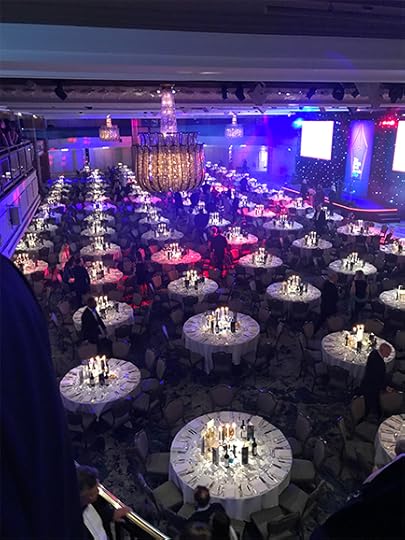
So then it was goat’s cheese parcels and medallions of lamb time and the heavy sense – I know that this is ridiculous, because this is a very competitive set-up – that I had invited 12 people to the Loser’s Table. We were up for two further awards: Independent Publisher of the Year and Children’s Publisher of the Year. I was 99.9% sure that Faber would, deservedly, win the Independent Publisher of the Year category in their 90th year and after such a brilliant 2018 run of commercial and prize-winning success. And honestly I didn’t think that we’d win Children’s Publisher of the Year because we’d lost to Bloomsbury at the Independent Publishers Guild and our competition for the award was both big and tough: DK, Hachette, HarperCollins, Macmillan, Scholastic, Usborne and Wonderbly.
Sure enough, Faber won Independent Publisher of the Year… but author/illustrator Kate Pankhurst announced that had we won Children’s Publisher of the Year.

This is why the organisers said we’d won:
Stellar growth in sales and profits in a broadly flat market
Breadth of creative publishing with superb design, production and marketing
Outstanding collaboration with UK and international publishing partners
Excellent care of authors and staff and commitment to inclusivity
This is a second Children’s Publisher of the Year Award in three years for Nosy Crow – reward for one of the most spectacular growth stories in UK publishing and even more remarkable achievement internationally.
At home, Nosy Crow saw its TCM sales rocket 32.9%, making it the 12th biggest children’s publisher just eight years after launching. Success here has been built on a breadth of publishing and formats rather than a few big names, and publishing partnerships with the likes of John Lewis, the British Museum and the National Trust began to fly in 2018.
But if it is performing well in the UK, Nosy Crow is even stronger in global markets, which account for well over half of its turnover. Sales, rights and coedition business all rose dramatically, with Asia and the US especially hot, and it had struck deals in 43 countries in all by the end of 2018.
Not even a decision to close its app department, a founding element of the business, could break Nosy Crow’s stride. Instead, it doubled down on new author and illustrator development; on creative projects like I am the Seed That Grew the Tree, an ambitious £25 hardback poetry collection with the National Trust; and on its game-leading marketing, led by energetic and engaging social media work.
It has all helped to create a very distinctive brand that resonates with authors, agents, bookseller and partner publishers around the world. “Nosy Crow are inspirational publishers and it is a sheer joy to work with them… they’ve sparked a buzz of creativity across the industry,” said one retailer in support of its nomination.
“It’s extraordinary growth by anyone’s standards,” added the British Book Awards judges. “They’ve blazed their way into the market and you can be sure that there’s so much more to come from them.”
I have been working in publishing for 33 years and never picked up a Nibbie myself – never gone onto the stage, heart beating too fast, deaf to the music that I hear so clearly every time someone else goes up, anxious that I’ll fall off my unwonted heels, wondering if the darns in the sleeve of my lucky dress will show on the big screen on which my face is the size of Lichtenstein. This is not for want of trying: I attempted to accept a Nibbie when we hadn’t been awarded one in 2014. And when we won the , I was in Sydney at the Allen and Unwin sales conference (they distribute our books in Australia and New Zealand) and I missed all the fun.
It is, I have to say, a GREAT feeling to get that unexpectedly heavy, nib-shaped prize in your hands… tempered last night only by my own sense of unpreparedness. You have a tiny amount of time to give a little acceptance speech. Before the event, you feel – well, I feel – that it would be an act of terrible hubris to write an acceptance speech. But as coffee is poured and the second half of the awards get underway you start scribbling on your place card the people you should thank, because, although I should probably have something terribly profound and important and industry relevant to say, the key thing is really just to say thank you, I reckon. And I couldn’t thank everyone who contributed to Nosy Crow’s success in 2018 – I’d have been up there for hours. As it was, I failed to thank The Bookseller for running the Nibbies and Tesco for sponsoring the Children’s Publisher of the Year Awards (sorry to you both if you are reading this).
This is what I said:
So thanks again to the judges, to our authors and illustrators, to all of our customers in the UK and beyond, to all of the growing band of Crows, to our shareholders, and to the adults who buy our books to share them with the children who are the future of our industry, and whose lives are immeasurably enhanced by our own books, and those made by the wide and increasingly diverse children’s publishing community.
We had a jolly, but not, you know, crazily bacchanalian time… because this morning we were all in the office working on the next books, the new books. And it was a pretty full-on day, which is why I am only managing to write this blog post now.

We did all break for Krispy Kremes, though, in the afternoon.

Publishing, and particularly children’s independent publishing, is a pretty great job to have every day. But last night and today it has felt like the best job in the world.


May 13, 2019
We Won an Island is now available as an audiobook
Today we’re delighted to share a brand new audiobook edition of We Won an Island by Charlotte Lo – a a hugely appealing and funny debut, perfect for fans of Gerald Durrell.
When Luna’s family win an island, Luna thinks it will solve everything AND she can finally get a donkey! But things don’t go entirely to plan – no one expects Luna’s younger brother to win a Sheep Pageant, for example – and the secret festival they hold soon spirals out of control. But the island is beautiful, and the family are happy, and maybe Luna will get her donkey after all…
Brilliantly narrated by Katherine Press, you can buy the audiobook of We Won an Island from Audible, Amazon, and Apple now – and you can listen to a preview of the audiobook below.
You can also read the opening of the book below:

May 9, 2019
The inspirations behind No Ballet Shoes in Syria – a guest post by Catherine Bruton
This month we’re incredibly proud to have published No Ballet Shoes in Syria by Catherine Bruton – a captivating story, filled with warmth and heart, with wonderfully authentic ballet writing and an important message championing the rights of refugees. The Times named it their Children’s Book of the Week, calling it “A moving, textured story … Ballet Shoes for the 21st century”, and Hilary McKay, Costa Book Prize-winning author of The Skylarks’ War, described it as “wise and kind and unputdownable”. And today we’re very pleased to share a piece by Catherine on the inspirations behind the book, which you can read below.
When I was eleven I adored Noel Streatfeild’s Ballet Shoes and Pamela Brown’s The Swish of the Curtain, and was so fixated on Lorna Hill’s Sadler’s Wells ballet books – each of which I had read at least ten times – that eventually my mum decided enough was enough. She prised my tattered copy of Veronica at the Wells out of my hands and gave me a pile of new reading material, which included The Silver Sword, When Hitler Stole Pink Rabbit, and The Diary of Anne Frank. That was when I discovered that there was a new kind of book to love – stories that could open your eyes, change the way you saw the world, make you ask questions, expand your horizons, enrich your soul – switch on lightbulbs in your head!
As an English teacher for the past twenty-five years I have had the great privilege of introducing kids to those ‘lightbulb books’ – the stories that expand their capacity for empathy and challenge their preconceptions about the world; that help them look at and come to terms with the most difficult issues of growing up in the world today.
And so as an author those are the books I have tried to write.
As the world watched the migrant crisis beginning to unfold I knew it was something I wanted – needed – to write about. Hearing Judith Kerr, the author of When Hitler Stole Pink Rabbit, speak about the parallels between her story and the current situation in Syria, I had my own lightbulb moment. I would write about a child displaced from their home by war in Syria, fleeing across Europe, and seeking asylum in the UK. A story that was a modern version of When Hitler Stole Pink Rabbit and The Silver Sword – a story that would make young readers look beyond the labels of ‘refugee’ and ‘asylum seeker’ to see the child behind.
When I discussed the idea with my editor at Nosy Crow, we were both conscious of the difficulties of writing about events that are happening now – complex, potentially troubling issues that we would be asking young readers to confront without the distance of history. I have a quote from one of my favourite writers, Alan Gibbons, above my desk: “I never enter a dark room unless I can light the way out.” That’s what I wanted to do – to confront difficult issues, in a way that didn’t offer glib solutions or whitewash the truth, but which did offer the consolation of hope.
A charity local to me, Bristol Refugee Rights, holds a drop-in at a community centre where dance lessons are also held. I found myself imagining a young Syrian girl, just arrived in the UK, disorientated, not knowing if she’d be allowed to stay, watching a ballet class through a half-open doorway, seeing girls just like her friends from home, longing to be back at her own dance school. The story began from there.
I contacted Bath Welcomes Refugees and other refugee resettlement projects who helped me with research, and I spoke to members of the Syrian community who had come to Britain, as well as reading many, many accounts and transcripts from child refugees, but I did find myself struggling for a long time with the voice. Aya’s voice eluded me – sometimes she was there, sometimes she slipped away from me, and tying together her past narrative with her present was particularly challenging. Until I realised that of course it would be – dealing with the past and reconciling it with the present is hugely difficult for many of these children. I made the decision to tell the story of Aya’s life in Aleppo – her experiences before and during the war, her flight through Turkey, in a container, in refugee camps, crossing the Med in a storm – all in flashbacks interspersed between the story of her experiences as a young asylum seeker in the UK. At first the two stories are distinct, but gradually dance becomes a medium for Aya to work through complex suppressed memories and the two begin to come together. As she becomes more able to talk about the past and grieve for what’s lost – coming to terms with what may have happened to her father – she is also able to begin to let go of the guilt and look to the future.
Telling Aya’s story felt like a big responsibility. Sometimes I wondered if it was my story to tell – and I hope that in future years we will see stories of child migrants told by those who lived through it. But it didn’t feel like this story could wait. It has to be told now – to this generation who are growing up now. Because when you turn on your TV and see a story about a Syrian refugee who has escaped the horrors of war, only to be attacked in a school in the UK, you realise why it is so important for this generation of young readers to question the toxic definitions attached to words like ‘refugee’ and ‘asylum seeker’ – to see the child, not the label.
But I hope this story might also be to young readers what Ballet Shoes and The Swish of the Curtain and the Sadler’s Wells series were to me – the stories of following your dreams that I adored and read over and over; that I read to my children and still pick up as old favourites today. My mum doesn’t take them off me now! She knows that the moment she pressed those lightbulb books into my hand, she helped me grow up as a reader – but it was the love of both kinds of books that made me a reader for life. If No Ballet Shoes in Syria can do that for any young readers, or if a child like Aya can read it and see themselves represented on the pages of a book – their story told, in which they are the heroine, not just a victim – then I will have done what I set out to do.
Thank you, Catherine! No Ballet Shoes in Syria is available in shops now – you can read the opening chapters below:
And here’s the first chapter of the audiobook edition of the book, available now from Audible, Amazon, and Apple.

Nosy Crow's Blog
- Nosy Crow's profile
- 35 followers



